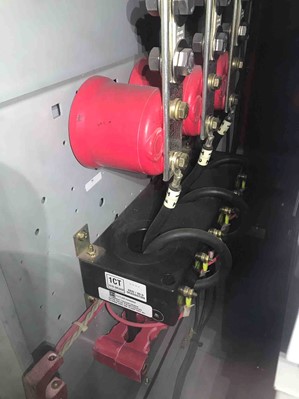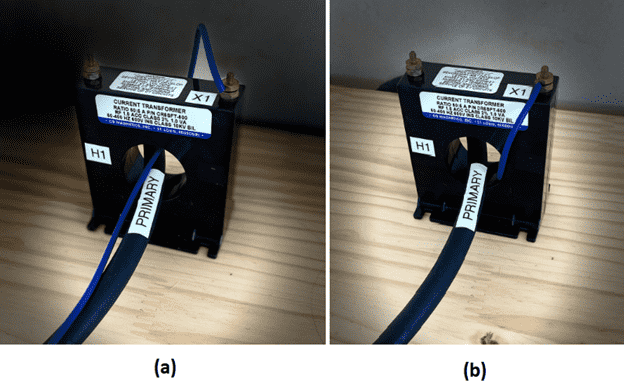Current Transformer [CT] ratio is specified for one turn or one pass of primary conductor through the window of CT. Often, users want CT ratio to be adjusted or modified to their specific needs and some fine tuning of CT ratio may be beneficial. This article goes over how CT ratio of a fixed ratio CT can be modified. For multi ratio CT the adjustment process is simple and is discussed in this article.
CT ratio can be adjusted by modifying primary turns, modifying secondary turns or both.
Adjusting CT ratio by modifying primary turns

In this method, primary conductor is passed one or more times through the window of CT. Figure 1 shows 150:5 CT that has primary conductor passed two times through CT window. Effective CT ratio is now 75:5. Note that this is a quick and easy way to reduce the CT ratio. CT ratio will be reduced by the number of times primary conductor is looped through the CT. Accuracy and burden characteristics of CT is not changed by adding more primary turns.
The disadvantage of this method first is that only a coarse adjustment is possible. Second problem is that for larger conductors, it may be physically impossible to pass the cable multiple times through the CT window due to cable being not flexible enough or risk of violating cable bending radius.
Formula for calculating CT ratio when multiple primary turns are used is as follows:

In figure 1 with 150:5 CT and 2 primary turns, the new ratio can be calculated to be 75:5 as shown below.

Adjusting CT ratio by modifying secondary turns
If finer adjustment of ratio is desired, secondary conductor can be routed through the window of CT in either additive or subtractive fashion to achieve the desired ratio. Secondary conductors are also smaller making it easier to pass multiple times through CT.
For a 5A secondary rated CT, the new primary rating can be obtained using the formula below:

In the formula above use ‘+’ if secondary wire is routed additively and ‘-‘ if secondary wire is routed subtractive. Figure 2 shows how secondary leads can be added or subtracted.

For adding secondary turns, pass X1 lead from H2 to H1 and for subtracting pass X1 lead from H1 to H2.
In figure 2 (a), name plate CT ratio is 50:5 with secondary lead passed one time additively (passed from H2 to H1). New CT ratio is 55:5 and can be calculated as:

In figure 2 (b), name plate CT ratio is 50:5 with secondary lead passed one time subtractive (passed from H1 to H2). New CT ratio is 45:5 and can be calculated as:

Thus, by using this simple trick we changed a 50:5 ratio CT to 55:5 and 45:5 ratio. By adding or subtracting more secondary leads, other ratios can be realized.
The disadvantage of this method first is that it will be difficult to troubleshoot or identify CT ratio (at a later date) unless new ratio is clearly marked. Second, if primary conductor is a medium voltage (>1KV) unshielded cable, routing secondary (600V rated) conductor through the same window can cause cables to physically touch each other which is not ideal. This article lists some of the issues with non-shielded MV cable touching other objects. Routing the cables so as to not physically touch can resolve this concern.
Read: Open circuited current transformer
Adjusting CT ratio by modifying primary and secondary turns
CT ratio may also be adjusted by changing both primary and secondary turns at the same time. Relationship between primary and secondary turns can be expressed in the formula below:

Example 1: Consider a 50:5 CT with two primary turns and one secondary turn. Secondary turn is subtractive (H1 to H2). What is the new ratio?
New ratio (Ka) can be calculated using equation below:

Example 2: Consider a 100:5 CT with two primary turns. How many secondary turns need to be made to convert this to a 60:5 ratio?

Four turns need to be added to achieve 60:5 ratio with given conditions.
Summary
Coarse adjustment of current transformer ratio can be obtained by routing the primary conductor through CT multiple times. If finer adjustment is desired, secondary conductor can be routed through CT window either additively or in subtractive fashion. CT ratio can also be adjusted by adjusting both primary and secondary turns simultaneously.
